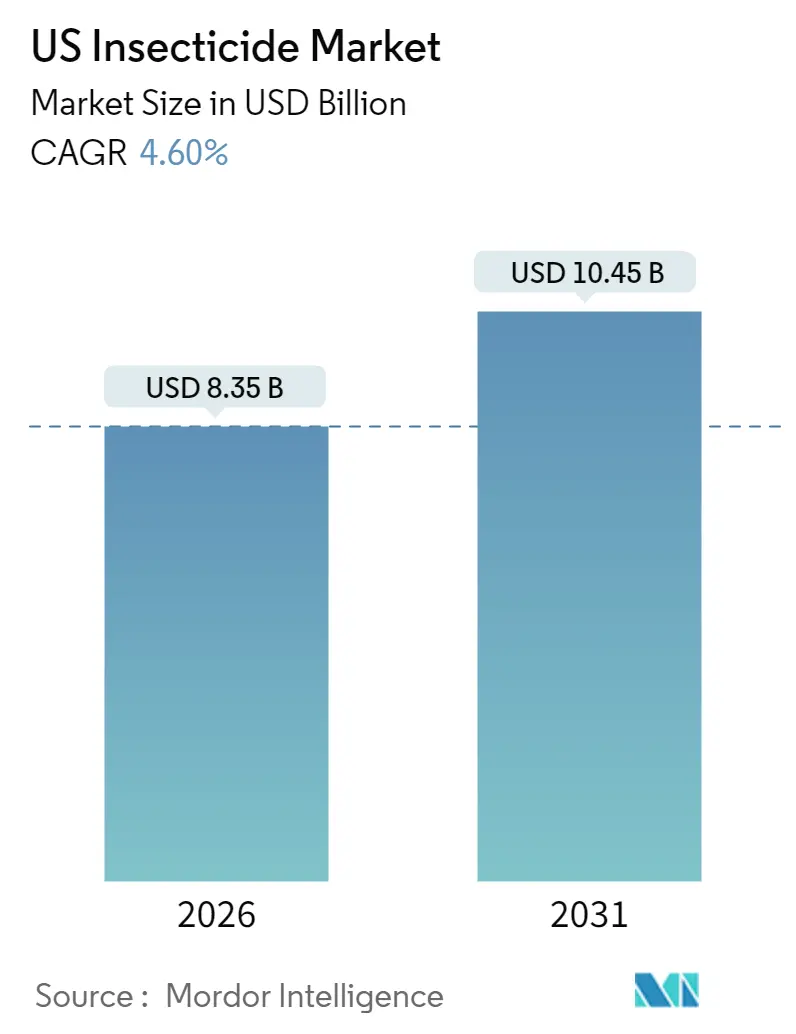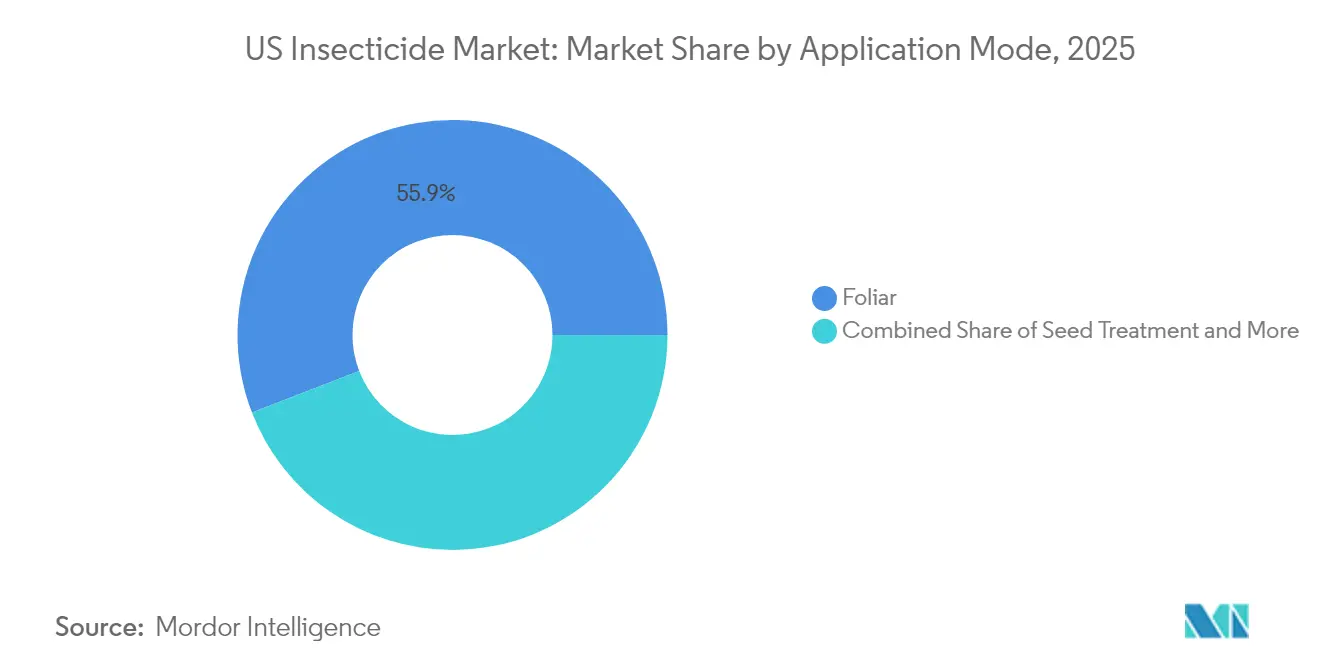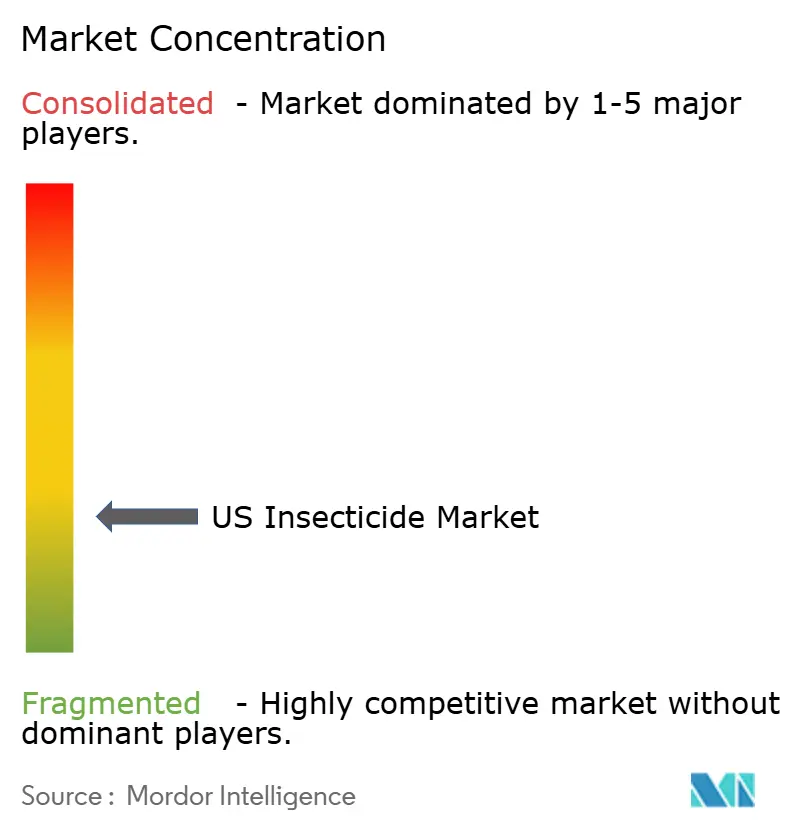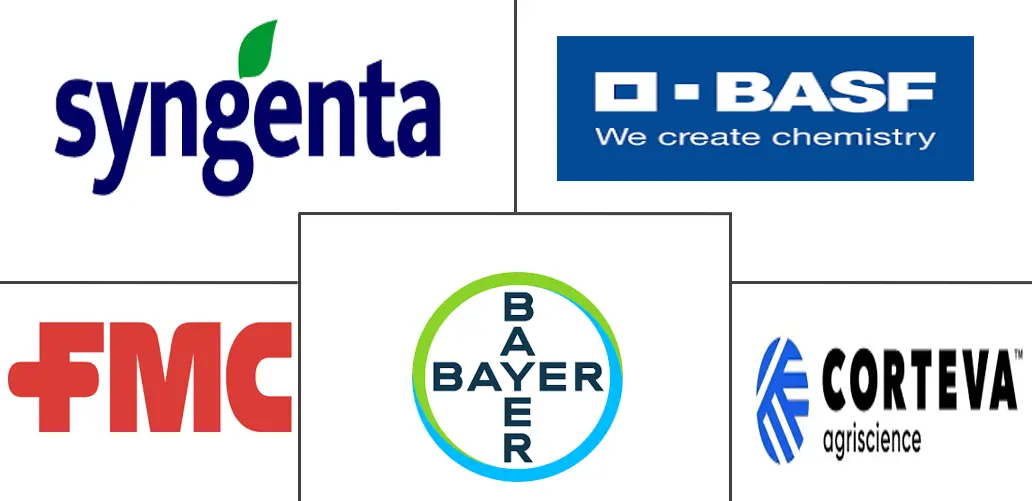US Insecticide Market Size and Share

US Insecticide Market Analysis by Mordor Intelligence
The US insecticide market was valued at USD 7.98 billion in 2025 and estimated to grow from USD 8.35 billion in 2026 to reach USD 10.45 billion by 2031, at a CAGR of 4.60% during the forecast period (2026-2031). Rising specialty-crop acreage, wider precision-agriculture deployment, and persistent resistance issues are sustaining demand even as regulatory scrutiny tightens. Growth also reflects the drive for earlier-stage protection through seed treatment, the premium assigned to low-rate active ingredients that lighten environmental loading, and escalating labor costs that favor automated or one-pass application tactics. While foliar sprays still dominate, the US insecticide market is steadily tilting toward technology-enabled approaches that reduce operator exposure and improve return on investment. Competitive strategies now center on portfolio breadth, regulatory adaptability, and integration with data platforms that support variable-rate decisions.
Key Report Takeaways
- By application mode, foliar sprays led with 55.87% of the US insecticide market share in 2025, whereas seed treatment posted the fastest growth at a 4.78% CAGR through 2031.
- By crop type, grains and cereals accounted for 44.22% of the US insecticide market size in 2025 and are expanding at a 4.74% CAGR to 2031.
Note: Market size and forecast figures in this report are generated using Mordor Intelligence’s proprietary estimation framework, updated with the latest available data and insights as of January 2026.
US Insecticide Market Trends and Insights
Drivers Impact Analysis
| Driver | (~) % Impact on CAGR Forecast | Geographic Relevance | Impact Timeline |
|---|---|---|---|
| Specialty-crop acreage expansion | +0.8% | California, Florida, and Pacific Northwest | Medium term (2-4 years) |
| Resistance management needs | +0.9% | Corn Belt, Cotton Belt, and National | Long term (≥ 4 years) |
| Growth in seed-treatment adoption | +0.7% | Midwest and Great Plains | Short term (≤ 2 years) |
| Approvals of low-rate AIs (Active Ingredients) | +0.6% | National | Medium term (2-4 years) |
| Protected agriculture demand | +0.4% | California, Arizona, and Controlled environments | Long term (≥ 4 years) |
| Drone-based precision spraying | +0.5% | Large-scale operations, Midwest | Medium term (2-4 years) |
| Source: Mordor Intelligence | |||
Specialty-Crop Acreage Expansion
Revenue potential per acre for almonds, citrus, and wine grapes grew markedly between 2020 and 2024, encouraging heavier investment in premium chemistry that meets export residue rules[1]Source: National Agricultural Statistics Service, “Chemical Use Surveys,” nass.usda.gov. In California, almond plantings rose 12% over the period, while Florida citrus recovery efforts enlarged insecticide programs aimed at Asian citrus psyllid suppression. Specialty crops often deliver three-to-five-fold higher gross returns relative to grains, so growers willingly adopt high-priced, reduced-risk formulations that protect both yield and quality. Climate shifts are simultaneously opening new production zones in the Pacific Northwest, widening the addressable acreage. As a result, the US insecticide market gains reliable volume from premium categories that absorb price increases without material demand destruction.
Resistance management needs
Regulatory mandates now codify rotation of modes of action for pests such as corn rootworm and cotton bollworm[2]Source: Environmental Protection Agency, “Reduced Risk Pesticide Program,” epa.gov. University extension data show 67% of corn growers implemented formal resistance programs in 2024 versus 23% in 2020, a shift that creates predictable peaks for newer actives while hastening obsolescence of aging compounds. Portfolio depth, therefore, becomes a revenue hedge, with suppliers able to fill entire seasonal plans, enjoying greater share security. Structured rotation also stimulates development of formulations that blend multiple actives, bundling insecticidal and fungicidal protection in single passes to ensure compliance and labor savings.
Growth in seed-treatment adoption
Seed treatment now covers 89% of corn acres, up from 76% in 2020, with soybean adoption climbing from 45% to 62% over the same span. The US insecticide market benefits because early-stage protection curbs costly re-sprays and anchors integrated pest management plans. No-till and minimum-till acreage magnify the technology’s value by leaving residue that shelters soil pests, making prophylactic treatment economically rational. Service providers further enhance uptake through bundled seed plus treatment offerings that simplify grower procurement.
Approvals of low-rate AIs (Active Ingredients)
The Environmental Protection Agency’s reduced-risk program shortened review time for chemistries that meet toxicity and residue criteria. Recently registered molecules require 50-80% lower kilograms per hectare yet command 40-60% price premiums per unit of active ingredient. That pricing structure offsets volume decline while keeping per-acre costs neutral, preserving revenue for manufacturers. Growers gain compliance advantages and simplified logistics from lighter loads, reinforcing conversion away from legacy options.
Restraints Impact Analysis
| Restraint | (~) % Impact on CAGR Forecast | Geographic Relevance | Impact Timeline |
|---|---|---|---|
| EPA-driven withdrawals | -0.7% | National | Short term (≤ 2 years) |
| Pollinator-health pressures | -0.5% | Agricultural regions with pollinator-dependent crops | Medium term (2-4 years) |
| GM insect-resistant traits | -0.6% | Corn Belt, Cotton Belt | Long term (≥ 4 years) |
| Applicator labor shortage | -0.4% | Rural agricultural regions | Medium term (2-4 years) |
| Source: Mordor Intelligence | |||
EPA-Driven Withdrawals
Regulatory withdrawals of established insecticide active ingredients are creating market disruptions that force rapid adoption of alternative chemistries, often at higher per-acre costs that strain grower economics while benefiting companies with robust replacement product portfolios. The EPA's 2024 decision to restrict neonicotinoid applications on pollinator-attractive crops eliminated approximately USD 340 million in annual market value, creating immediate demand for alternative chemistries that command premium pricing due to limited supply. These regulatory actions are accelerating industry consolidation as smaller companies struggle to maintain viable product portfolios amid shrinking chemistry options.
Pollinator-Health Pressures
Scientific consensus linking certain chemistries to bee mortality spurred buffer-zone rules and timing curbs that complicate foliar programs in almond, apple, and melon production areas. Some specialty crops now mandate evening-only applications or expanded pre-bloom intervals, effectively shortening treatment windows. These operational constraints push growers to preventive measures such as treated seed or soil systemic options, shifting revenue away from traditional contact sprays.
Segment Analysis
By Application Mode: Seed Treatment Gains Momentum
Foliar sprays led with 55.87% of the US insecticide market share in 2025, whereas seed treatment posted the fastest growth at a 4.78% CAGR through 2031, anchored by their versatility across crop systems. The US insecticide market size for seed treatment is poised to eclipse by 2031 if current penetration continues. Adoption is supported by evidence that a single coating delivers four-to-six-week protection at up to 40% lower total cost than comparable foliar-only programs. Labor savings are significant because treated seed enters the soil in one operation, eliminating additional passes. Regulatory pressure also favors closed-system seed coaters that reduce applicator exposure.
Demand for chemigation and drip injection rises where irrigation infrastructure permits, especially in water-limited regions aiming for simultaneous pest and moisture management. Fumigation retains a niche in strawberry beds and nursery stock but exhibits minimal growth. Soil treatments remain important in perennial orchards where root-zone protection is critical. Product development now focuses on encapsulated microgranules and biological inoculants that complement systemic actives, offering sustained release throughout root flushes. Together, these trends illustrate the diversified pathway through which the US insecticide market accommodates evolving agronomic and labor realities.

Note: Segment shares of all individual segments available upon report purchase
By Crop Type: Grains and Cereals Drive Market Expansion
Grains and cereals commanded 44.22% of 2025 revenue and are projected to grow at a 4.74% CAGR. Intensifying corn and soybean rotations elevates pest carryover, especially when reduced tillage leaves residue on the surface. Variable-rate technology fine-tunes application density, aligning input spend with soil pest hotspots. The US insecticide market share for grains surged during the 2025 fall armyworm outbreak, underscoring pest volatility as a revenue lever.
Fruits and vegetables remain the most lucrative on a per-acre basis, with residue compliance dictating frequent use of low-dose formulations. Commercial crops such as cotton still depend on insecticides despite near-saturation trait adoption because refugia and resistance mitigation require complementary chemistry. Pulses and oilseeds enjoy steady growth as plant-based protein demand expands, encouraging acreage in the Northern Plains. Turf and ornamentals offer margin upside through premium labels tailored to aesthetic quality standards, although volumes are smaller. Collectively, these crop-specific patterns confirm the depth and breadth of the US insecticide industry’s end-user base.

Note: Segment shares of all individual segments available upon report purchase
Geography Analysis
The Corn Belt, spanning Iowa, Illinois, Indiana, and Nebraska, consumes a good share of the national insecticide volume because prolonged growing seasons foster overlapping pest generations. Growers there invest heavily in seed-applied and in-furrow options to contain early soil pest outbreaks. California, with fewer acres yet higher sales value, anchors specialty-crop revenue; strict state regulations accelerate migration to low-rate actives and drone spraying that limit off-target drift. The Southeast’s humid climate sustains multicycle pest pressure in cotton, peanut, and vegetable systems, prompting integrated regimens combining Bt traits, foliar sprays, and biologicals.
Texas leads individual state consumption due to its diverse agricultural base spanning cotton, corn, sorghum, and specialty crops across varied climatic zones that support year-round pest activity. Pacific Northwest orchards and vineyards prioritize formulations that secure fruit integrity for export, adopting mating-disruption pheromones alongside reduced-risk sprays. The Great Plains’ wheat and sorghum growers lean on seed treatment to mitigate narrow spray windows caused by volatile spring weather.
Climate change is nudging southern pests northward, compelling growers in Minnesota and the Dakotas to adopt chemistries previously confined to warmer zones. Regional compliance nuances complicate label selection; for instance, California’s Department of Pesticide Regulation often imposes stricter cutoffs than the federal standard. Consequently, suppliers must tailor distribution and stewardship programs to local rule sets to preserve market access.
Competitive Landscape
The US insecticide market exhibits low concentration, while numerous mid-tier and niche participants occupy the balance. BASF SE, Bayer AG, FMC Corporation, Syngenta Group, and Corteva Agriscience leverage expansive research and development pipelines and longstanding channel partnerships to retain volume. Syngenta and FMC round out the leadership group through specialty-crop portfolios and service offerings. Competitive intensity intensified after neonicotinoid restrictions, which opened shelf space for alternative actives and biologicals.
Companies differentiate on resistance-management positioning; portfolios with multiple modes of action will fare better under mandated rotation plans. Digital integration also proves decisive; Bayer’s 2025 purchase of AgTech Solutions embeds AI models into Climate FieldView, allowing predictive sprays that customers perceive as value added. Similar logic drove Syngenta’s alignment with John Deere to sync equipment telemetry with prescription maps that dose insecticide only where thresholds warrant.
Startups progress in microbials and RNA-interference products that promise species-specific control without collateral toxicity. Although current sales are modest, venture funding has risen steadily, signaling confidence in disruptive potential. Established players increasingly partner with or acquire these innovators to accelerate regulatory submissions and capture early-mover advantage. Over the forecast, companies able to marry chemistry, genetics, and data analytics into cohesive platforms are best positioned to defend share and margin.
US Insecticide Industry Leaders
BASF SE
Bayer AG
Corteva Agriscience
FMC Corporation
Syngenta Group
- *Disclaimer: Major Players sorted in no particular order

Recent Industry Developments
- May 2025: BASF SE obtained EPA approval for isocycloseram, a broad-spectrum contact insecticide. The product targets lepidopteran pests and other insects affecting specialty crops.
- November 2024: Corteva Agriscience initiated a USD 3 billion share repurchase program. The company also opened a USD 30 million distribution center in Anderson, Indiana, to handle corn and soybean seeds.
- November 2023: FMC Corporation launched its next-generation seed treatment platform combining three active ingredients in a single formulation, reducing application complexity while providing comprehensive protection against soil-dwelling and early-season foliar pests in corn production systems.
US Insecticide Market Report Scope
Chemigation, Foliar, Fumigation, Seed Treatment, Soil Treatment are covered as segments by Application Mode. Commercial Crops, Fruits & Vegetables, Grains & Cereals, Pulses & Oilseeds, Turf & Ornamental are covered as segments by Crop Type.| Chemigation |
| Foliar |
| Fumigation |
| Seed Treatment |
| Soil Treatment |
| Commercial Crops |
| Fruits & Vegetables |
| Grains & Cereals |
| Pulses & Oilseeds |
| Turf & Ornamental |
| Application Mode | Chemigation |
| Foliar | |
| Fumigation | |
| Seed Treatment | |
| Soil Treatment | |
| Crop Type | Commercial Crops |
| Fruits & Vegetables | |
| Grains & Cereals | |
| Pulses & Oilseeds | |
| Turf & Ornamental |
Market Definition
- Function - Insecticides are chemicals used to control or prevent insects from damaging the crop and prevent yield loss.
- Application Mode - Foliar, Seed Treatment, Soil Treatment, Chemigation, and Fumigation are the different type of application modes through which crop protection chemicals are applied to the crops.
- Crop Type - This represents the consumption of crop protection chemicals by Cereals, Pulses, Oilseeds, Fruits, Vegetables, Turf, and Ornamental crops.
| Keyword | Definition |
|---|---|
| IWM | Integrated weed management (IWM) is an approach to incorporate multiple weed control techniques throughout the growing season to give producers the best opportunity to control problematic weeds. |
| Host | Hosts are the plants that form relationships with beneficial microorganisms and help them colonize. |
| Pathogen | A disease-causing organism. |
| Herbigation | Herbigation is an effective method of applying herbicides through irrigation systems. |
| Maximum residue levels (MRL) | Maximum Residue Limit (MRL) is the maximum allowed limit of pesticide residue in food or feed obtained from plants and animals. |
| IoT | The Internet of Things (IoT) is a network of interconnected devices that connect and exchange data with other IoT devices and the cloud. |
| Herbicide-tolerant varieties (HTVs) | Herbicide-tolerant varieties are plant species that have been genetically engineered to be resistant to herbicides used on crops. |
| Chemigation | Chemigation is a method of applying pesticides to crops through an irrigation system. |
| Crop Protection | Crop protection is a method of protecting crop yields from different pests, including insects, weeds, plant diseases, and others that cause damage to agricultural crops. |
| Seed Treatment | Seed treatment helps to disinfect seeds or seedlings from seed-borne or soil-borne pests. Crop protection chemicals, such as fungicides, insecticides, or nematicides, are commonly used for seed treatment. |
| Fumigation | Fumigation is the application of crop protection chemicals in gaseous form to control pests. |
| Bait | A bait is a food or other material used to lure a pest and kill it through various methods, including poisoning. |
| Contact Fungicide | Contact pesticides prevent crop contamination and combat fungal pathogens. They act on pests (fungi) only when they come in contact with the pests. |
| Systemic Fungicide | A systemic fungicide is a compound taken up by a plant and then translocated within the plant, thus protecting the plant from attack by pathogens. |
| Mass Drug Administration (MDA) | Mass drug administration is the strategy to control or eliminate many neglected tropical diseases. |
| Mollusks | Mollusks are pests that feed on crops, causing crop damage and yield loss. Mollusks include octopi, squid, snails, and slugs. |
| Pre-emergence Herbicide | Preemergence herbicides are a form of chemical weed control that prevents germinated weed seedlings from becoming established. |
| Post-emergence Herbicide | Postemergence herbicides are applied to the agricultural field to control weeds after emergence (germination) of seeds or seedlings. |
| Active Ingredients | Active ingredients are the chemicals in pesticide products that kill, control, or repel pests. |
| United States Department of Agriculture (USDA) | The Department of Agriculture provides leadership on food, agriculture, natural resources, and related issues. |
| Weed Science Society of America (WSSA) | The WSSA, a non-profit professional society, promotes research, education, and extension outreach activities related to weeds. |
| Suspension concentrate | Suspension concentrate (SC) is one of the formulations of crop protection chemicals with solid active ingredients dispersed in water. |
| Wettable powder | A wettable powder (WP) is a powder formulation that forms a suspension when mixed with water prior to spraying. |
| Emulsifiable concentrate | Emulsifiable concentrate (EC) is a concentrated liquid formulation of pesticide that needs to be diluted with water to create a spray solution. |
| Plant-parasitic nematodes | Parasitic Nematodes feed on the roots of crops, causing damage to the roots. These damages allow for easy plant infestation by soil-borne pathogens, which results in crop or yield loss. |
| Australian Weeds Strategy (AWS) | The Australian Weeds Strategy, owned by the Environment and Invasives Committee, provides national guidance on weed management. |
| Weed Science Society of Japan (WSSJ) | WSSJ aims to contribute to the prevention of weed damage and the utilization of weed value by providing the chance for research presentation and information exchange. |
Research Methodology
Mordor Intelligence follows a four-step methodology in all our reports.
- Step-1: Identify Key Variables: In order to build a robust forecasting methodology, the variables and factors identified in Step-1 are tested against available historical market numbers. Through an iterative process, the variables required for market forecast are set and the model is built on the basis of these variables.
- Step-2: Build a Market Model: Market-size estimations for the forecast years are in nominal terms. Inflation is not a part of the pricing, and the average selling price (ASP) is kept constant throughout the forecast period.
- Step-3: Validate and Finalize: In this important step, all market numbers, variables and analyst calls are validated through an extensive network of primary research experts from the market studied. The respondents are selected across levels and functions to generate a holistic picture of the market studied.
- Step-4: Research Outputs: Syndicated Reports, Custom Consulting Assignments, Databases & Subscription Platforms








